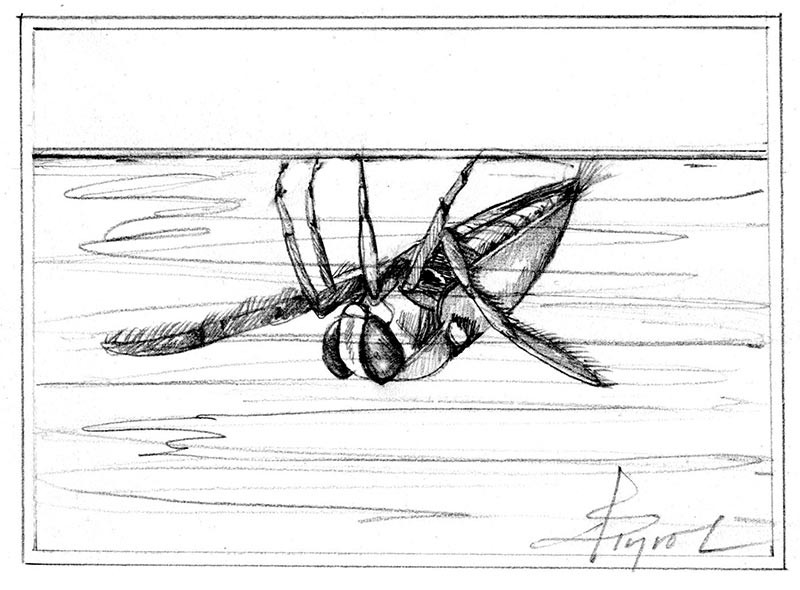
I had just finished my safety talk to some middle school students when I heard a bloodcurdling scream. In many years handling aquatic insects and other small water creatures, I have never been wounded. Crayfish have once or twice gotten hold of me but never drawn blood. So I was quite surprised to hear through the minor chaos that a student had actually been bitten.
There were no crayfish where we sampled in Winooski floodplain ponds and only one likely candidate to produce such a scream. It was the reason I had specifically warned my students to use forceps.
Backswimmers are also called “water bees,” and according to Dr. James Diaz of the Louisiana State University School of Medicine, they frequently deliver a painful bite when threatened. Unlike their shorter-beaked cousins the water boatmen, backswimmers have long, segmented beaks that easily penetrate human skin. They use these fearsome beaks to dispatch prey that range in size from insects smaller than themselves all the way up to small fish and amphibians. The chemicals that paralyze their prey likely cause more pain to occasional human victims than does the physical injury.
As their common name indicates, backswimmers swim on their backs. This is not an occasional convenience as might suit you or me; this is the only way these insects swim. Everything about their anatomy, coloration, and behavior fits with this unusual adaptation.
Many aquatic cousins of backswimmers, including water striders, water boatmen, and more distant relatives such as diving beetles, use countershading to be less visible. Their backs are dark to match the pond floor when viewed from above; their undersides are pale to blend with the sky. Backswimmers buck this trend because their dark “undersides” are viewed from above. Their paler pearlescent backs obscure them from any potential predator coming from below.
In common with other insects, backswimmers’ six legs grow from the ‘underside’ of the thorax, except of course that they face up toward the water surface. When they feel the need to dive, a pair of powerful oar-like back legs propel them to the pond floor where they can hang on and remain submerged for extended periods.
Staying submerged is a choice in spring, summer, and into the cooler months of autumn, but what happens in winter? Thick ice entombs backswimmers along with many of their aquatic neighbors. One might expect these insects to hibernate, but nothing could be further from the truth. While we skate across a frozen lake, or drill a hole to fish, backswimmers remain active below, hunting prey and growing.
So how do they survive in such a cold, poorly oxygenated environment? Partly through economy; in colder temperatures, their metabolism and corresponding need of oxygen is somewhat diminished. They also carry bubbles with them – these are attached to grooves in the abdomen that are surrounded by hydrophobic hairs. The bubbles are replenished by oxygen diffusing from the water.
The bubbles also serve as a means of passive locomotion. Backswimmers are members of one of only three insect families that use hemoglobin to store large quantities of oxygen. They can shunt oxygen from their hemoglobin into their external bubbles and back again: when they shrink their bubbles, they sink down in the water; when they emit oxygen from abdominal tissues into their bubbles, they rise upward.
This remarkable trick allows them to maintain a resting state of neutral buoyancy. It reduces their energy costs, and thereby helps them survive harsh winter conditions.
And speaking of enduring harsh conditions, what about that middle school insect bite victim? He jerked his hand away, and the offending backswimmer landed at the feet of a colleague. His hand swelled up a little, but he was a trooper and even seemed to enjoy the attention as we cleaned and applied antiseptic and a band-aid to his hand. He jumped right back into the lesson with enthusiasm and a lot more heed to my warning to use forceps.


Discussion *